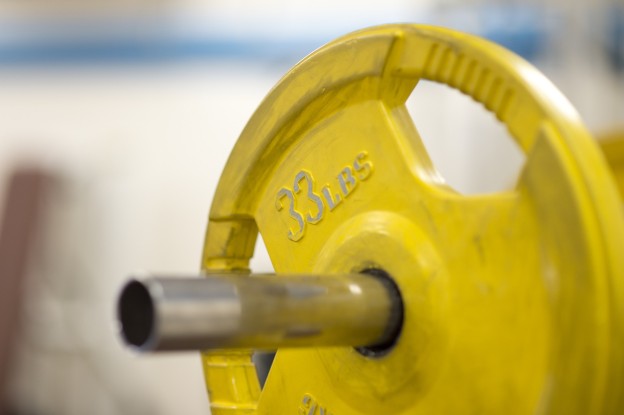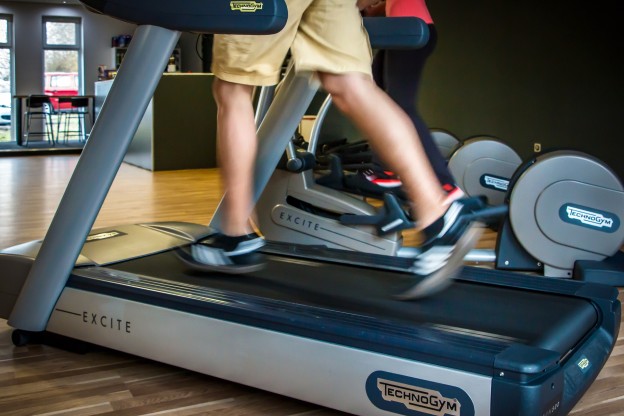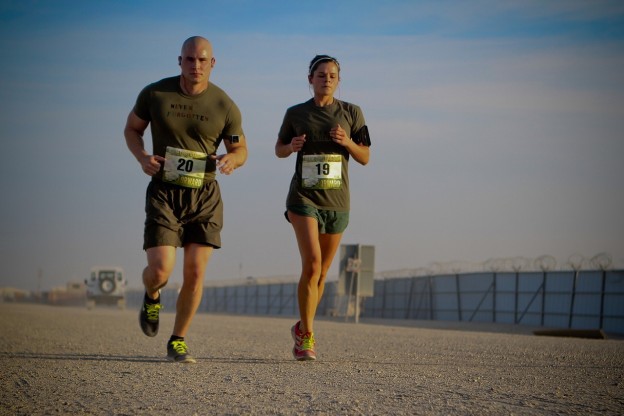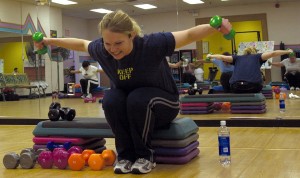How HIIT works. HIIT training has really exploded in popularity in the last few years. HIIT stands for High Intensity Interval Training.
How HIIT works
And with good reason. High intensity interval training works! But if you want HIIT to work for you, you need to know how to make it part of your exercise routine.
You see, long, slow, boring cardio isn’t the best way to lose fat and bring out that sexy, lean muscle you have hidden under there.
Old fashioned cardio can be part of an overall program that helps you burn fat, but the “bang for your buck” isn’t as great as HIIT.
If you don’t know what high intensity interval training workouts are, in the most basic form, you perform short bursts of high intensity exercise (like sprints), with brief periods of rest.
For example, you might sprint the straightaway of a track and slow jog the turns and repeat for 8 or 10 “sets” (intervals).
It’s not an easy way to work out, but your workouts will be shorter and you’ll love the results. If you do HIIT correctly. And this is where a lot of people run into problems with interval training.
Regular cardio doesn’t burn nearly as many calories as most people think it does. Want to know how many calories are burned during a marathon of 26.2 miles? Sure, it varies from person to person based on body weight, lean muscle mass, how fast you run, etc. but on average a marathoner burns about 2,500 to 3,500 calories running one marathon.
There are 3,500 calories in a pound of fat!
Let’s say that’s how many calories you would burn running a marathon. So if you eat the exact number of calories your metabolism burns off in a week all you have to do is add a marathon every week and you’ll drop a pound a week!
That sounds great, doesn’t it? There’s also the small problem that a good percentage of that weight would be muscle, you wouldn’t lose just fat.
Have you seen what a marathon runner looks like? Is that the body you want? I didn’t think so.
And that’s assuming that your calorie intake and calorie burn are equal. Most people start exercising because they’ve gained weight, ie, are eating more calories than they are burning off.
And let’s face it, if you did run a marathon every week, you know you’d be eating a lot more than you are right now!
So if you don’t want to run a marathon or two every week AND you actually want to get results from your exercise program, what’s left? High intensity interval training workouts, of course! (and yes, some changes to your diet, too!)
With interval training, you get a one two punch of calories burned DURING your workout, as well as calories burned AFTER your workout (up to 39 hours!)!
Due to the high intensity nature of HIIT training, you will see an increase in excess post-exercise oxygen consumption (EPOC).
What this means is that your metabolism will stay elevated for many hours after you are finished the exercise, allowing you to burn more calories even while doing nothing. This is how HIIT works
There is little to no EPOC from a low intensity session, meaning your metabolism does not rise, and you burn few, if any calories after the exercise session is over.
Another study had individuals perform either an endurance training (ET) or interval training routine for a period of 15 weeks.
The interval training group experienced 9 times as much fat loss as those performing the endurance training program.
Numerous studies have shown that HIIT increases both one’s aerobic and anaerobic workout capacity while endurance training just improves the former.
It has also been shown that intense interval training actually increases aerobic capacity to a better degree than traditional low intensity aerobics.
So how do you use HIIT training effectively? This is very important, because improper training will lead to over training, burn out, injury, a loss of muscle mass and a slower metabolism! My guess is you aren’t working out and eating right to get those kind of results!
Interval training is intense, and while you will improve your aerobic and endurance capacity, you also highly tax your anerobic system as well.
It’s much more like a weight training workout, as far as how it affects your muscles. This means you shouldn’t do interval training workouts more than 3 or 4 times per week, you shouldn’t do them two days in a row, and these workouts should NOT be long!
Interval training focuses on quality over quantity. This is how HIIT works. Forget 45 minute or 60 minute sessions. Not with HIIT you don’t.
Heck, the most famous study done on interval training, by Dr. Tabata on speed skaters, involved all out work for 20 seconds, followed by 10 seconds of rest, repeated 8 times. Yes, that’s a FOUR MINUTE WORKOUT!
And the speed skaters all significantly improved their aerobic and anerobic capacity.
One of the other great things about hiit is that you do not need equipment. Sure, you can do it quite well on a stationary bike or treadmill but you can also go outside and do sprints (hill sprints rock!), perform jump rope workouts (okay, technically that’s a piece of equipment) or do bodyweight exercises, either in a circuit training routine, or just one killer exercise like burpees for a number of intervals.
And if you follow the rule above about limiting your workout sessions so you don’t over train, you also won’t have to worry about burning away your lean muscle mass, wreaking havoc with your metabolism and looking like a marathon runner. Wouldn’t you rather look like a sprinter?
What type of workout do you think sprinters do? That’s right! High intensity interval training workouts!
Add two or three hiit training sessions a week, along with a good quality resistance training program and you’re on your way to fat burning, lean muscle building success!
STUDIES: R. Bahr, et al., “Effect of Intensity on Exercise and Excess Post-Exercise O2 Consumption,” Metabolism 40.8 (1991):836-841.
J. Smith, et al, “The Effects of Intensity of Exercise and Excess Post-Exercise Oxygen Consumption and Energy Expenditure in Moderately Traine Men and Women,” European Journal of Applied Physiology 67 (1993): 420-425.
A. Tremblay, et al, “Impact on Exercise Intensity on Body Fatness and Skeletal Muscle Metabolism,” Metabolism 43.7 (1994):814-818
G. Rhodas, et al, “A Short Training Programme for the Rapid Improvement of Both Aerobic and Anaerobic Metabolism,” European Journal of Applied Physiology 82.5-6 (2000):480-486
Are you interested in more fitness info? Check out my free report:
“10 FITNESS HACKS YOU NEED TO KNOW”









 the gym and start working out. You know you’ve gotten yourself out of shape and an hour or so in the gym three or four days a week sure wouldn’t hurt.
the gym and start working out. You know you’ve gotten yourself out of shape and an hour or so in the gym three or four days a week sure wouldn’t hurt.